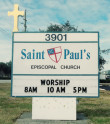The hopes and fears of all the years...

Sunday Sermon
The Rev. Dr. Thomas A. Thoeni
Rector
Dec. 25, 2019
The Rev. Phillips Brooks became the rector of Trinity Church, Boston, in the year 1869, when he was just 34 years old. Three years after his arrival in Boston, his church burned to the ground. It took the congregation four years of worshiping in temporary sites before they could rebuild their church.
During this time, a period when most churches would suffer and shrink in membership, Trinity grew and flourished.
The growth was such that the new church was built in an up and coming area of Boston known as Copley Square. The building, and the building project, was adventurous and stands to this day as one of Boston’s architectural treasures. It was from Fr. Brooks' brave and strong leadership that the parish was able to literally rise from its own ashes and grow into one of the Episcopal Church’s finest and best known parishes.
Phillips Brooks, known as a powerful preacher, was claimed by many as the best American preacher of the 19th Century. He was also known as a gentle, sensitive and caring pastor. He was, in short, the model priest. But his career was not without its challenges and low points. One of the more demanding periods for him as a young priest was leading his flock during the Civil War. The war was demoralizing to many. It seemed it would never end. The number of injured and dead were mounting with each day and the news seemed to be nothing but bad. The war took a great toll on the national consciousness.
Fr. Brooks was increasingly unable to offer his flock hope and comfort for his own mood was darkening by the day. To pout it in our own vernacular,
Father Brooks was burnt out and quite likely in a depression. He decided to take a sabbatical in order to rest and regain his spiritual strength. He traveled to the Holy Land, and while there, was invited to help with Christmas Eve services in Bethlehem. Though he did not feel up to the task, he accepted the invitation. Late in the afternoon he rode on horseback from Jerusalem to Bethlehem.
He entered Bethlehem just as night fell and was amazed to find himself overlooking a field of shepherds watching their flocks by night. He paused and took in the scene with all its simple beauty. At that moment Phillips Brooks began to feel his spirit lift. He began to feel renewed. The services that night rang with joy and Father Brooks reveled in the hope of his Savior.
A few years later, he found himself in his study, pacing the floor trying to prepare a Christmas sermon. The memories of that Christmas in Bethlehem returned to him. He went to his desk, pushed aside his sermon notes and wrote a poem, capturing the beauty and the hope of that event. We know the poem. In fact, we just sang its words.
During this time, a period when most churches would suffer and shrink in membership, Trinity grew and flourished.
The growth was such that the new church was built in an up and coming area of Boston known as Copley Square. The building, and the building project, was adventurous and stands to this day as one of Boston’s architectural treasures. It was from Fr. Brooks' brave and strong leadership that the parish was able to literally rise from its own ashes and grow into one of the Episcopal Church’s finest and best known parishes.
Phillips Brooks, known as a powerful preacher, was claimed by many as the best American preacher of the 19th Century. He was also known as a gentle, sensitive and caring pastor. He was, in short, the model priest. But his career was not without its challenges and low points. One of the more demanding periods for him as a young priest was leading his flock during the Civil War. The war was demoralizing to many. It seemed it would never end. The number of injured and dead were mounting with each day and the news seemed to be nothing but bad. The war took a great toll on the national consciousness.
Fr. Brooks was increasingly unable to offer his flock hope and comfort for his own mood was darkening by the day. To pout it in our own vernacular,
Father Brooks was burnt out and quite likely in a depression. He decided to take a sabbatical in order to rest and regain his spiritual strength. He traveled to the Holy Land, and while there, was invited to help with Christmas Eve services in Bethlehem. Though he did not feel up to the task, he accepted the invitation. Late in the afternoon he rode on horseback from Jerusalem to Bethlehem.
He entered Bethlehem just as night fell and was amazed to find himself overlooking a field of shepherds watching their flocks by night. He paused and took in the scene with all its simple beauty. At that moment Phillips Brooks began to feel his spirit lift. He began to feel renewed. The services that night rang with joy and Father Brooks reveled in the hope of his Savior.
A few years later, he found himself in his study, pacing the floor trying to prepare a Christmas sermon. The memories of that Christmas in Bethlehem returned to him. He went to his desk, pushed aside his sermon notes and wrote a poem, capturing the beauty and the hope of that event. We know the poem. In fact, we just sang its words.
O little town of Bethlehem,
how still we see thee lie!
Above thy deep and dreamless sleep
the silent stars go by;
yet in thy dark streets shineth
the everlasting Light;
the hopes and fears of all the years
are met in thee tonight.
Each year, as Christmas approaches, I think of this hymn, and especially the last line of the first verse, “the hopes and fears of all the years are met in thee tonight.” In that one phrase Fr. Brooks recalled his dark spirit as he looked over that field on Christmas eve. In that one phrase Fr. Brooks caught his own dilemma and his need for hope. In that one phrase Fr. Brooks captured for us our own dilemmas and our need for hope, as well. In that one phrase, Fr. Brooks captured the truth of the Incarnation, the mystery of our God made flesh, the blessed hope of all God’s people.
The hopes and fears of all the years
are met in Christ this night.
This night, as we quiet our minds and spirits to hear the blessed story of our Savior’s birth, we do so not because it is a gentle story of a babe born in remarkable circumstances. We gather tonight to hear the story of our God’s arrival among us.
The birth of Jesus is not simply the tale of another child born into a broken world. The birth of Jesus is the tale of Immanuel, of God with us, of God with us in our very lives, our breath, our tangible world, our DNA, our hopes, our fears, through all of our years. Tonight we mark the beginning of God’s sojourn among us. We mark the darkest night, in the darkest moment, when the Light of the World shone about us and among us so that our dark moments and nights, and even spirits, may be given life and light.
We gather tonight to rest and to rejoice that our hopes and fears are met within our God. Our most terrifying and troublesome worries are within the palm of God. Our most consoling and comforting desires are within the heart of God. With the eyes of faith, weak though they may be, we can look into that manger and see deep into the love of our God. We can be assured and renewed, no matter what grim darkness this world may bring, whether it is war, famine, disease, apathy, or loneliness, our God is present. We can be assured and renewed that no matter how fragile our hopes, whether it is that we be healed, forgiven, restored, revitalized, reborn, or remade, our God is present.
There, so many years ago, in a tiny town, in a cold and dank manger, the hope and fears of all the years, of all our hearts and souls, were met in our incarnate Lord. That is why we gather tonight. That is why we sing tonight. That is why Phillips Brooks wrote the following,
The birth of Jesus is not simply the tale of another child born into a broken world. The birth of Jesus is the tale of Immanuel, of God with us, of God with us in our very lives, our breath, our tangible world, our DNA, our hopes, our fears, through all of our years. Tonight we mark the beginning of God’s sojourn among us. We mark the darkest night, in the darkest moment, when the Light of the World shone about us and among us so that our dark moments and nights, and even spirits, may be given life and light.
We gather tonight to rest and to rejoice that our hopes and fears are met within our God. Our most terrifying and troublesome worries are within the palm of God. Our most consoling and comforting desires are within the heart of God. With the eyes of faith, weak though they may be, we can look into that manger and see deep into the love of our God. We can be assured and renewed, no matter what grim darkness this world may bring, whether it is war, famine, disease, apathy, or loneliness, our God is present. We can be assured and renewed that no matter how fragile our hopes, whether it is that we be healed, forgiven, restored, revitalized, reborn, or remade, our God is present.
There, so many years ago, in a tiny town, in a cold and dank manger, the hope and fears of all the years, of all our hearts and souls, were met in our incarnate Lord. That is why we gather tonight. That is why we sing tonight. That is why Phillips Brooks wrote the following,
O holy Child of Bethlehem, descend to us, we pray;
cast out our sin and enter in, be born in us today.
We hear the Christmas angels the greatest tidings tell;
O come to us, abide with us, our Lord Emmanuel.
Merry Christmas
© 2019, Tom Thoeni
SUPPORT ST. PAUL'S DONATE NOW OR RECURRING DONATION

3901 Davis Blvd., Naples, Florida 34104 239-643-0197 Office hours 9 a.m. to 1 p.m. Monday-Friday


